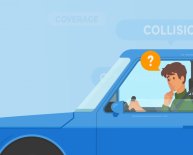
How to find auto insurance?

By Keith Selvin
I’ve spent the majority of my career in the insurance industry, and every day I see how many misconceptions people have about how auto insurance works. One common refrain is that “I’ve been paying into this insurance policy for years and never filed a claim. What good is insurance if you never use it? Of course I’m going to file a claim on that $600 hit-and-run in the Walmart parking lot.”
1. “At-fault accident” does NOT mean it was your fault.
Have you ever been rear-ended by a driver who didn’t have insurance and filed a claim to get your car fixed? If so, congratulations: you now have an at-fault accident on your record. Insurance companies don’t really care whose fault it was – they care about the statistical likelihood that they’ll have to pay out on a claim. That means if you’re the “type of person” (read: normal) who files a claim without any third-party insurance information (because they don’t have insurance), your insurer records having to pay a claim with a 0% chance of subrogation. (Look it up, fellers.)
Okay, fine. The Wikipedia page is terrible and full of legalese. Basically, subrogation means the act of one insurance company reimbursing another. When you get rear-ended by a driver who does have insurance, your insurance company still pays to fix your car in the short term, but is simultaneously communicating with the third party’s (meaning the jerk who ran into you) insurance company. When their insurance company reimburses your insurance company completely, it becomes a “not at-fault accident.”
“Great, ” you think, “I’ve been rear-ended, the other person had insurance, their company paid for my damages, I did nothing wrong. I’m in the clear!” And the answer to that is no, no you’re not, because…
2. “Not at-fault accidents” count against you too.
“Now wait just a minute. Someone hit ME! That’s true, but while you, dear reader, may be a beacon of truth and light, we live in a dishonest time. There is a TON of insurance fraud out there. How easy would it be to purposely rear-end your buddy, who just happens to work in an auto repair shop, collect on the insurance, and get the car fixed for virtually nothing (labor is almost as expensive as parts in some cases), and double your money for half a day’s work?The answer is that it’s not really hard at all, which is why insurance companies look at the big picture. How accident-prone is this person? Too many “not at-fault” accidents on their record? Most higher-end insurance companies won’t even sell you a policy. Again, it all comes down to risk assessment.
In many states there are no-fault laws, which means that the fault of the accident doesn’t have to be completely attributed to one party. The accident can, for example, be 80% John’s fault and 20% Jane’s fault. I can’t tell you have many customers say that their driving record is clean, “except for that one no-fault accident I was in. But someone hit me! After running a CLUE report (an accident and claims history), an at-fault accident appears and the price nearly doubles.
Why? While John rear-ended her at 70 mph, he may also have been in the other lane and swerved to avoid a deer. The insurance companies refer to the police report, see the whole story, and come to an agreement that John’s insurance company is liable for 80% of the damage, while Jane’s insurance will cover the remaining 20%. You just got an at-fault accident on your record for doing absolutely nothing. Hooray!
In all seriousness, insurance boils down to statistics and risk assessment. Companies look at the raw data and say, “Welp, we know this accident wasn’t her fault, but it does indicate that she is more accident-prone than people who never file claims, and therefore is more likely to cause us to pay out in the future – because math. Which brings me to my next point…
3. Don’t file frivolous claims. Seriously.
As an insurance agent, I’ve looked at a lot of driving records. This means both Motor Vehicle Reports and CLUE reports (tickets and accidents/claims, basically). I can count the number of completely clean, claim- and violation-free records I’ve seen on two hands. And maybe a couple toes. Okay, I’ve seen probably seen more than 20 pristine records over the years, but the point is that they’re rare. Like unicorns, really.

















